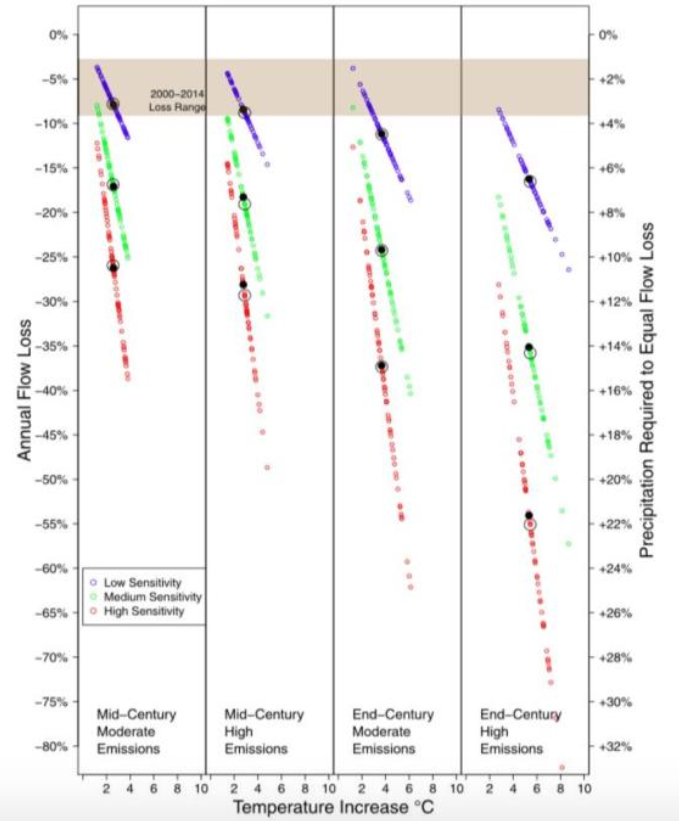Over the last fifteen years, an average of nineteen percent reduction in annual flow through the Colorado River has put the spotlight on growing concerns about water shortages throughout the southwest. Everyone from industries to individuals rely on a constant supply of fresh water, and a shortage of this precious resource will have wide-ranging and profound impacts on society. Scientists are now examining the geologic history of the Colorado River basin to form a clearer picture of what we might expect in the future while also considering the compounding effects of climate change.
In 1976 the first reconstruction of past Colorado River flows was created using dendrochronology, where the spaces between tree rings are used to reconstruct past climatic conditions. In this initial reconstruction scientists found that the early twentieth century had the highest flows of the period from 1520 to 1976. These relatively high flows during the initial formation of water policy on the Colorado River likely caused some over allocation of water when the Colorado River Compact was created in 1922. Further tree-ring studies going back to 268 B.C. showed even higher levels of flow variability, with periods of prolonged drought lasting over one-hundred years. On the whole, these past reconstructions indicate that the flows we witnessed in the first part of the twentieth century may have been atypically high, and mean flows over geologic time are in fact much lower.
How will climate change affect future flows on the Colorado River?
The potential for the Colorado River to return to more typical previous flow levels is particularly concerning given the compounding effects of climate change. Although there has been little consensus on how precipitation levels will change in the Colorado River basin as a result of climate change, models have used an approximation of a 6.5% loss in river flow for every one degree Celsius of future warming. One model showed that with the continuation of moderate greenhouse gas emissions, we could observe a 25% loss of flow in the Colorado River by the end of the century. This would require a 10% increase in precipitation to make up for the loss, which is exceedingly unlikely given predictions of future precipitation patterns. As climate change progresses and increases in severity, there is little doubt that we are more likely to experience prolonged periods of drought like the ones we have observed in the geologic past.

Policy Implications: How can we reduce the severity and impacts of future droughts?
Climate change prediction models, and particularly those examining future drought potential, have many people concerned and wondering how to address this significant issue. There are both global and local actions that can be taken to help lessen and mitigate the impact of future droughts in the Colorado River basin. The first, and perhaps most difficult, is a generalized reduction of greenhouse gas emissions to lessen the amount of future climate change that we will experience. However, this is a global issue and one that cannot be easily solved on a large scale without international cooperation.
There are also more local actions that can be taken to address this issue. The first is decreasing local demand for water through increasing agriculture use efficiency and planting more water efficient crops. It is also imperative that the public be made more aware of the increasing severity of drought and water shortages. Public awareness and education campaigns could help encourage people to reduce their personal water usage. Many states have successfully cut water use during acute droughts only to allow consumption to increase again once rain returns. Such successes are proof that we can permanently reduce our collective water use. Education of the public can certainly help encourage reduction of individual water consumption, but there will likely have to be some government mandates in place to achieve permanent water use reduction goals. Targeted public education could help to reduce the fallout from such unpopular legislation.
Additionally, we need more data to improve climate model accuracy and decrease uncertainty. Scientific research involving past climate reconstructions has helped us create more accurate models for future predictions, and additional funding for research in this field will further increase our ability to understand the challenges we will face.
Future drought is a serious concern throughout the Southwestern United States. Examining patterns of water flow in the Colorado River on geologic time scales has revealed past mean flows that are lower than the flows generally seen in the first half of the twentieth century. These overall lower past flows combined with the future exacerbation of drought from climate change combine to create a pressing issue in need of attention. Efforts to reduce water use and increase public awareness of this issue are imperative to address a warmer, drier future.
Udall, B. & Overpeck, J. (2017). The twenty-first century Colorado River hot drought and implications for the future. Water Resources Research, 53, 2404– 2418.
